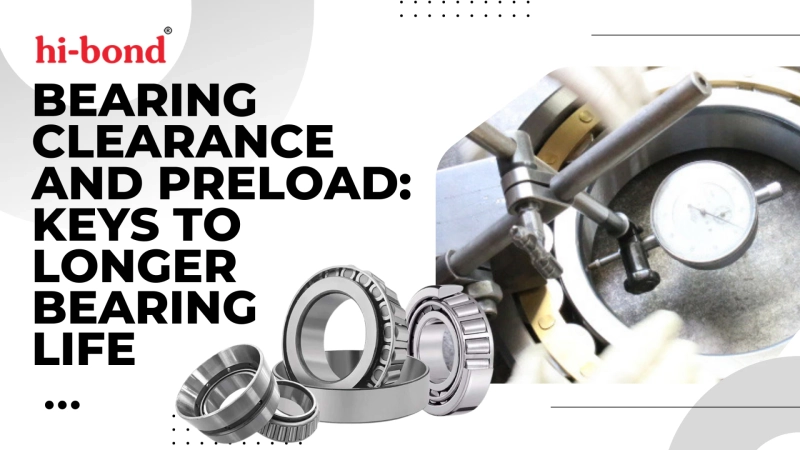Bearings are necessary for the smooth operation of industrial machines and rotating equipment. For this purpose, accuracy and precision are required to extend the life of the bearing. Also, two crucial parameters essential for extending the performance of bearings in frictionless machine movement are bearing clearance and preload.
Whether you are working with roller bearings, deep groove ball bearings, or any other types of bearings from a reliable bearing manufacturing company, getting the right balance between these two aspects can make the overall difference between smooth-running machines and those machines suffering from early wear and bearing failure.
Particularly, bearing clearance plays a critical role in ensuring that the rolling elements of these mechanical components move freely while still maintaining enough contact for support and stability. This blog discusses the meaning of preload and clearance, how they primarily affect bearing life, and things you can perform to optimize them for variable operating situations.
Why Bearing Clearance and Preload Are Critical for Bearing Life
The simple, tiny mechanical component may appear straightforward at first glance, but its ultimate purpose is far from it. These bearings need to carry axial and radial loads, run at higher speeds, and withstand changes in operating temperature and lubrication.
Every design decision affects the bearing's lifespan. In this scenario, preload and clearance play a vital role in providing precision in machine performance. The clearance means the small amount of space inside the bearing that allows rolling elements to move.
In contrast, preload is the controlled force applied to a bearing to remove the internal clearances. Both purposes directly affect operating conditions, overall bearing life, and practical energy efficiency.
When the clearance is too large, the perfect rolling elements may not distribute loads evenly. This process can cause excessive noise, vibration, and premature bearing wear. In contrast, if the clearance is very restricted, the bearing will overheat, resulting in damage to the outer rolling elements and rings.
On the other hand, preload offers stability in versatile applications with rapid starts, stops, or changes in direction. Without it, bearings could instantly shift and lose accuracy under axial loads.
Various Types Of Bearing Clearance
There are various internal clearances to take into consideration while working with bearings:
- Radial Clearance: The total movement of the inner ring related to the outer ring in a radial direction perpendicular to the bearing axis.
- Axial Clearance: The number of movements of the inner ring compared to the outer ring of bearings in a direction parallel to its axis.
Bearing manufacturers primarily design bearings with a specific clearance to meet unexpected operating conditions.
For example, in high-temperature or high-speed applications, larger clearances in the basic bearing parts may be required because the inner ring expands more than the outer ring. In contrast, in precision applications, with restricted tolerances, one may benefit from smaller clearances or even preload.
What Is Bearing Preload and Why Does It Matter
The typical bearing preload is the critical opposite function of clearance. Instead of allowing a gap, a preload is applied to the axial load that presses the rolling elements into their proper place.
This advanced method removes internal play and boosts rigidity. Preload is utilized in various applications where shaft positioning is critical, particularly in machine tools and automotive gearboxes.
There are different types of preload, which indicate:
- Fixed Preload: It is achieved by adjusting elements during bearing assembly, such as tightening nuts or spacers, to ensure a consistent preload.
- Spring Preload: This method uses a spring element to apply a consistent force, even when operating conditions change entirely.
Both methods primarily aim to improve performance by reducing vibration, improving accuracy, and prolonging bearing lifespan under specific operating conditions.
How Operating Conditions Affect Clearance and Preload
Choosing the proper clearance or preload requires monitoring of the operating environment to ensure optimal performance.
Bearings rarely work under perfect conditions. Various types of factors, like load direction, lubrication quality, temperature fluctuations, and shaft alignment, can all influence how much clearance and preload are necessary.
Multiple clearances in specific applications can cause unnecessary friction. Similarly, advanced deep groove ball bearings are used in electric motors at high speeds, which need the correct internal clearance to reduce heat buildup and energy loss.
The Vital Role Of Operating Temperature
One of the most ignored parameters when setting clearances and preload is extreme temperature. Metals expand when they are heated, and bearings also enlarge with high temperature. Primarily, the inner rings of the bearings expand more than the outer rings because they are securely mounted on rotating shafts.
As a final result, a bearing from reliable bearing manufacturers with the correct clearance at room temperature may end up with zero clearance or excessive preload after the machine reaches its operating temperature.
It is a significant reason engineers calculate and adjust clearances during installation to match real-world conditions. Experiencing failure to measure clearances can remarkably shorten bearing life.
Practical Applications and Bearing Designs
Different bearing designs require various approaches to clearance and preload.
Angular contact ball bearings are designed explicitly for preload, making them ideal for applications that involve both axial and radial loads.
Deep groove ball bearings are widely used. They primarily operate with small clearances and are sensitive to preload settings in high-precision applications.
Roller bearings can perform radial loads and are used with larger clearances to manage shaft deflection.
The primary thing is understanding the role of the bearing in the overall system and how its design connects with the required speed, load, and extreme temperature.
Primary Errors To Prevent
- Neglecting Lubrication: Even the best preload or clearance environment cannot match the adverse effects of improper lubrication practices. The oil lubricants help manage heat and reduce friction.
- Ignoring Load Directions: Specialized bearings created for radial loads may not perform well under axial loads unless specified.
- Avoiding Internal Clearances During Installation: Installing a bearing without monitoring its specified clearance range can result in poor performance.
- Applying Excessive Preload: Too much preload generates unnecessary friction, increases heat, and reduces bearing life.
Practical Tips For Longer Bearing Life
- Consider the effect of operating temperature on internal clearances.
- Use measuring tools during installation to check the perfect settings.
- Always follow the guidelines of bearing manufacturers for clearance and preload recommendations.
- Select the proper oil lubricant and follow appropriate maintenance schedules.
- Regularly monitor operating environments such as noise and temperature, as these are early signs of bearing problems.
Get a Larger Bearing Lifespan And Longevity With Perfect Bearing Clearance and Preload
Bearing clearance and preload may seem like minor details, but they are significant elements in achieving longer bearing life and smoother machine operation.
Engineers can make informed decisions that keep bearings reliable for more years by understanding the relationships between operating temperatures and internal clearances.
Suppose it is deep groove ball bearings in consumer items, roller bearings in heavy machinery, or precision designs for aviation, the perfect balance between clearance and preload makes a vast difference.
Trusted bearing manufacturers play a considerable role by providing suitable bearing designs and perfect guidance to match specific applications.
Paying attention to these factors ensures efficiency and satisfaction, knowing that your machine is designed for higher longevity.


